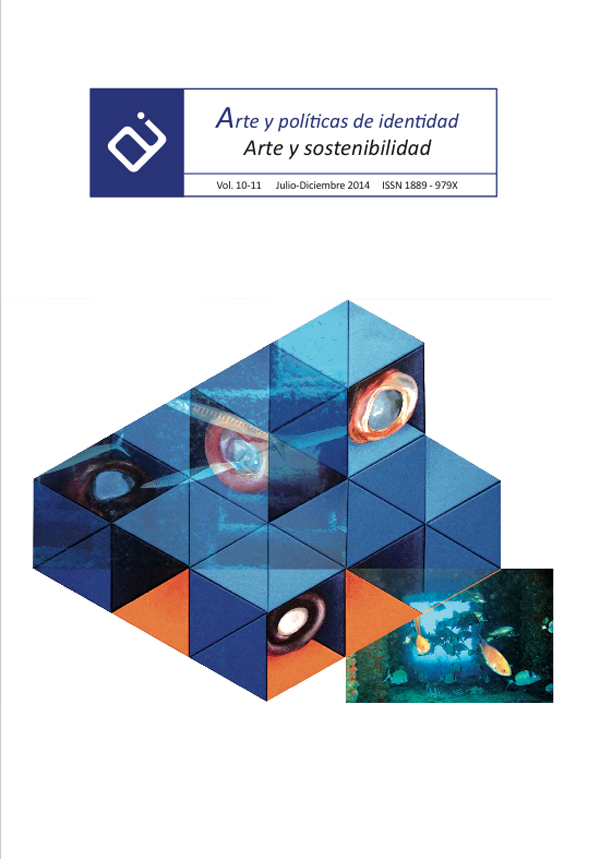Earthbeat: Environmental Art to Balance Our Rhythm
Abstract
From our origins, the human being has respected his natural surroundings for his own survival. Unless certain cultures, who still survive into their original environment, we have been distanced from the heartbeat of the earth (earthbeat). Art, as any ecological action, can help us to become aware.Since the late nineteenth century, until the mid-sixties ecological movements have been developed in defense of the natural spaces and sustainable actions within the urban environment. We research collective actions that reforest brownfields and create urban gardens and individual actions that use a visual language to induce in the viewer a new experience and contact with the ground.
Downloads
-
Abstract708
-
PDF (Español (España))569
References
Arredondo, D., Collados, A. y Gor, C. (2014). Lugares al límite. El paisaje en transición de la Vega de Granada. Granada: TRN-Laboratorio artístico transfronterizo / Ciengramos.
Fukuoka, M. (1978). The one-straw revolution, an introduction to natural farming. New York: Rodale Press. (Editado y traducido por Instituto Permacultura Montsant) [29 de Abril de 2014] Disponible en http://www.webislam.com/media/2012/07/54112_la_revolucion_de_una_brizna_de_paja.pdf (en línea).
F.R.R. (2012). El proyecto ‘Culturhaza’ expone la muestra ‘La misma vida como’. (Gabinete de Comunicación UJA). Jaén: Diario Digital Ujaen. [17 de Abril de 2014] Disponible en http://diariodigital.ujaen.es/node/32807 (en línea)
González, C. y Mateo, E. (2013). Nuevo huerto en Tetuán. Madrid: Asociación Moemia. [17 de Abril de 2014] Disponible en http://moenia.es (en línea).
Grande, J. K. (2005). Diálogos Arte y Naturaleza. Lanzarote: Fundación César Manrique.
Kastner, J. y Wallis, B. (2005). Land Arty Arte Medioambiental. Barcelona: Phaidon.
Lago González, E. (Coord.) (2005). Caxigueiro. Lugo: Museo Provincial de Lugo / Deputación Provincial de Lugo.
Lebrero Stäls, J. (2012). Entrevista a Joseph Beuys. Lápiz, 269/207,pp 29-35.
Ortuzar, M. (2011). Beuysiana. Vigo: Universidad de Vigo.
Pujana, Inés, (2011). Guerrilla Gardeners: jardineros de guerrilla. Madrid: La Nacion. [20 de Abril de 2014] Disponible en http://blogs.lanacion.com.ar/jardin/huerta-2/guerrilla-gardeners-jardineros-de-guerrilla/ (en línea).
Ramírez, J. A. y Carrillo, J. (2004). Tendencias del arte y arte de tendencias a principios del siglo XXI. Madrid: Cátedra.
Rodríguez Fernández, P. (Presid.) (2014). Boletín de AsociaciónCultural Ecolóxica Ridimoas. Orense: Ridimoas. [25 de Abril de 2014] Disponible en http://ridimoas.wix.com/ridimoas (en línea).
Sánchez, C. (2009). Ciro. Vilagarcía de Arousa, Pontevedra: Concello de Vilagarcía de Arousa.
Salgado, S. (2013). The silent drama of photography. New York: TED. [24 de abril de 2014] Disponible en http://www.ted.com/talks/sebastiao_salgado_the_silent_drama_of_photography (en línea).
Smithson, R. (1993a). El paisaje entrópico. Una retrospectiva 1960-1973. Nuria Enguita (coord.) Valencia: Institut Valencià d ́art Modern.
----- (1996b). Robert Smithson: The Collected Writing. Jack Flam (ed.). Berkeley y Los Angeles: University of California Press , LTD. London, England. [29 de abril de 2014] Disponible en www.robertsmithson.com (en línea).
Soler Ruiz, M. I. (2003). Reflexiones en el espacio: Incidents of mirror-travel in the Yucatan de Robert Smithson. Granada: Facultad de Bellas Artes, Universidad de Granada.
Martínez, D. y Fernández Puñal, J.R. (Dirs.) (2011). II Bienal Internacional de Fotografía y Artes Audiovisuales Fotojaén ́11. Jaén: Galería Uno de uno.
Viladomiu Canela, À. (2013). Urban Gardening: espacio de creación, crítica social y activismo ecológico. AUSART Journal for Research in Art1 (1), diciembre: 99-106. Bilbao: UPV.
Works published in this journal are subject to the following terms:
- The Service of Publications from the University of Murcia (publishing house) keeps the published works’ copyrights, and favors and allows the reuse of these works under the license indicated in point 2.
- Works are published in the journal’s online edition under the license Creative Commons Reconocimiento-NoComercial-SinObraDerivada 3.0 España(texto legal). They can be copied, used, disseminated, transmitted and publicly exhibited, as long as: i) the author and original source of publication are cited (journal, publishing house and work’s URL); ii) they are not used for commercial purposes; iii) the existence and specifications of this license are mentioned.
3. Conditions for auto-file. It is allowed and encouraged that authors share electronically their pre-print version (the pre-reviewed version) and /or post-print version (the reviewed and accepted version) of their Works before the publication, since it promotes its circulation and dissemination. RoMEO color: green.










